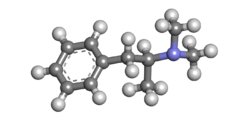Chemistry:Dimethylamphetamine
 | |
 | |
| Clinical data | |
|---|---|
| Routes of administration | Oral |
| ATC code |
|
| Legal status | |
| Legal status |
|
| Identifiers | |
| |
| CAS Number | |
| PubChem CID | |
| ChemSpider | |
| UNII | |
| KEGG | |
| Chemical and physical data | |
| Formula | C11H17N |
| Molar mass | 163.264 g·mol−1 |
| 3D model (JSmol) | |
| |
| |
| | |
Dimethylamphetamine (Metrotonin), also known as dimetamfetamine (INN), dimephenopan and N,N-dimethylamphetamine, is a stimulant drug of the phenethylamine and amphetamine chemical classes. Dimethylamphetamine has weaker stimulant effects than amphetamine or methamphetamine and is considerably less addictive[1] and less neurotoxic compared to methamphetamine.[2][3] However, it still retains some mild stimulant effects and abuse potential,[4] and is a Schedule I controlled drug.
Dimethylamphetamine has occasionally been found in illicit methamphetamine laboratories, but is usually an impurity rather than the desired product. It may be produced by accident when methamphetamine is synthesised by methylation of amphetamine if the reaction temperature is too high or an excess of methylating agent is used.[5][6]
It is said to be a prodrug of amphetamine/methamphetamine.[7]
References
- ↑ "Behavioral effects of N-methylamphetamine and N,N-dimethylamphetamine in rats and squirrel monkeys". The Journal of Pharmacology and Experimental Therapeutics 253 (2): 466–74. May 1990. PMID 2338643.
- ↑ "Evaluation of the neurotoxic potential of N,N-dimethylamphetamine: an illicit analog of methamphetamine". Brain Research 490 (2): 301–6. June 1989. doi:10.1016/0006-8993(89)90247-3. PMID 2765865.
- ↑ "N-methylation dissociates methamphetamine's neurotoxic and behavioral pharmacologic effects". Brain Research 771 (1): 115–20. October 1997. doi:10.1016/s0006-8993(97)00801-9. PMID 9383014.
- ↑ "Reinforcing effects of enantiomers of N,N-dimethylamphetamine in squirrel monkeys". Psychopharmacology 107 (2–3): 315–8. 1992. doi:10.1007/BF02245154. PMID 1615131.
- ↑ "Microgram Bulletin". US Drug Enforcement Administration. http://www.justice.gov/dea/pr/micrograms/2005/mg0205.pdf.
- ↑ "The Identification of d-N,N-Dimethylamphetamine (DMA) in an Exhibit in Malaysia". US Drug Enforcement Administration. http://www.erowid.org/library/periodicals/microgram/microgram_journal_2003-2.pdf.
- ↑ Forensic Medicine: Fundamentals and Perspectives. Springer Science & Business Media. 9 October 2013. pp. 519–. ISBN 978-3-642-38818-7. https://books.google.com/books?id=yHHABAAAQBAJ&pg=PA519.
 |

